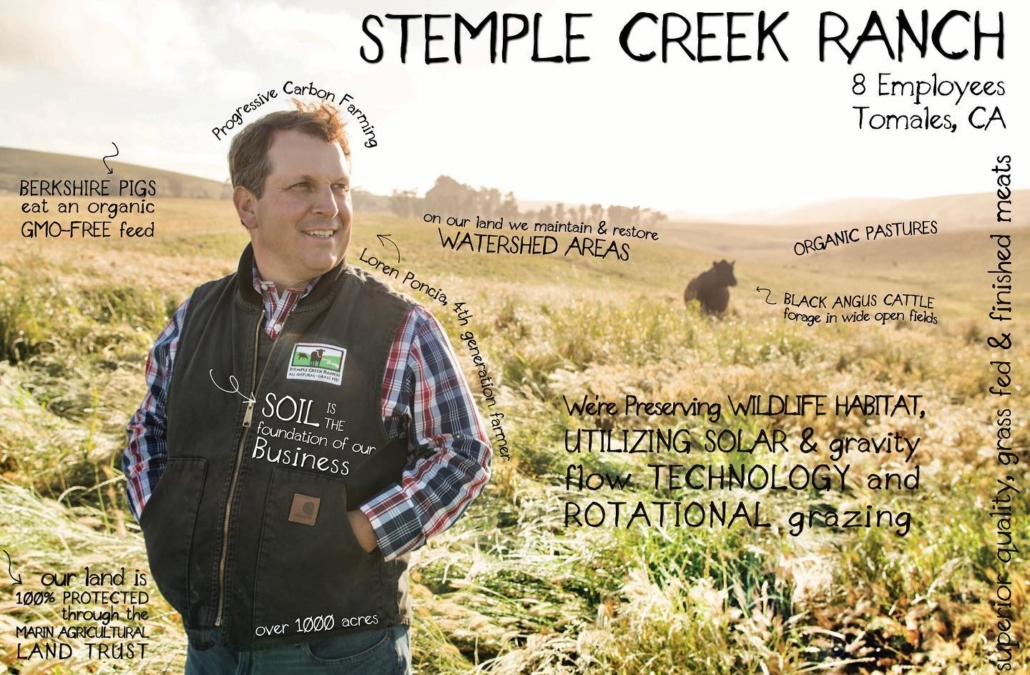Trails of Regeneration: Stemple Creek Ranch Survives COVID-19 by Selling Direct to Consumers
“Trails of Regeneration” is covering the effects of COVID-19 and gathering stories from regenerative farmers, ranchers and ecosystem experts on how the world is rapidly changing and what it means for biodiversity and regenerative food, farming and land use.
TOMALES, California — Spread of the coronavirus is causing major disruptions in the U.S. food supply chain, as several major meat processing plants have closed their doors and farmers are being forced to dump milk, break eggs and plow under perfectly good produce.
With the closing of schools, restaurants and businesses, farmers have had to find new and creative ways to connect their products to consumers. The latest episode in our “Trails of Regeneration” video series features a rancher on the frontline of COVID-19 and his journey in adapting to the challenges posed by the pandemic.
Husband and wife, Loren and Lisa Poncia, own Stemple Creek Ranch, a 1,000-acre regenerative farm located in the coastal hills of Northern California. At the ranch, purposeful rotational grazing is key to producing high-quality pastured and humanely raised animal products. It also works to promote biodiversity by preserving sensitive wildlife habitat and restoring natural watersheds.
Like many farmers around the world, the Poncias have been hit hard by the coronavirus outbreak. In an exclusive interview with Regeneration International, Loren explains how his farm lost 95 percent of its restaurant business seemingly overnight.
The farm’s direct-to-consumer sales, on the other hand, have increased significantly. “Our online sales are skyrocketing,” Loren told Regeneration International in a Zoom interview. He and his 15 employees—while practicing social distancing and wearing protective gear—are working around the clock to cut and package products to be shipped direct to customers.
The couple has also seen an increase in sales at their local farmer’s markets.
“We sell at two farmers markets in northern San Francisco that are going strong. People are coming out to buy directly from us,” said Loren. “What we noticed is that people are buying more than usual because they are no longer eating out and are forced to prepare 21 homecooked meals a week and that requires a lot of food.”
For decades, the organic regenerative food movement has advocated for more direct-to-consumer sales and better access to local food. That vision is gaining momentum amid the pandemic. As the industrial food supply chain breaks down amid COVID-19, demand for locally produced food has surged.
“In my local community people are united in helping and watching out for their neighbors, so we’re actually seeing a surge in solidarity,” said Loren.
Stemple Creek Ranch practices purposeful grazing to improve soil health
In 2013, Stemple Creek Ranch was asked to participate in a 10-year study with the Marin Carbon Project, a consortium of independent agricultural institutions in Marin County, California. The project’s mission is to increase carbon sequestration in rangeland, agricultural and forest soils to mitigate the effects of climate change.
The Marin Carbon Project required the ranch to complete a soil assessment before applying organic compost to a portion of pastureland in an effort to increase soil carbon. The benefits were enhanced by purposefully grazing livestock, which help stomp the compost into the ground and leave behind natural fertilizer.

On its website, the ranch says it’s “excited to be on the forefront of this ground-breaking research that is showing how best agriculture practices can harness atmospheric carbon to improve soil content on farms, and mitigate the effects of global warming.”
The regenerative practices not only build resilience on the ranch, but they also help educate consumers and get them excited about where their food comes from, said Loren, adding that it’s a win-win for food and farming, human health and the environment.
“Smallhold regenerative farmers are a resilient bunch and we can get through this because we have all the fertility we need on our farm,” Loren said.
“With COVID-19, we are seeing provisions for inputs such as chemical fertilizers and pesticides getting tighter, and their distribution becoming more complicated. Hopefully, it will push some to look at using compost, worm teas and the greatness of soil health, adopting things like they were before World War II when we didn’t need to use chemicals.”
Despite the challenges, farming in a pandemic has presented the ranch with new opportunities to evolve its business model. The internet has been especially helpful, giving farmers and ranchers around the world the ability to share their successes and failures with one another.
“We’ve been able to learn from each other by sharing ideas and learning from one another’s mistakes,” said Loren. “I think there’s a lot of really good things that could take off for small-scale agriculturists around the world.”
As far as the quarantine goes, Loren said there’s no other place he would rather be than confined to his ranch with his family.
“I am really enjoying the fact that I am confined with my family and that I am eating three meals a day with my family and appreciating the bounty we are able to partake on a daily basis,” Loren said.
“We are adapting and changing to the challenges, trials and tribulations that keep heading in our direction, with things we can’t even predict. So work is very hard, long and stressful but we are making more time to break bread as a family and eat together, which is really awesome.”
Oliver Gardiner is Regeneration International’s media producer and coordinator for Asia and Europe. To keep up with Regeneration International news, sign up for our newsletter.
